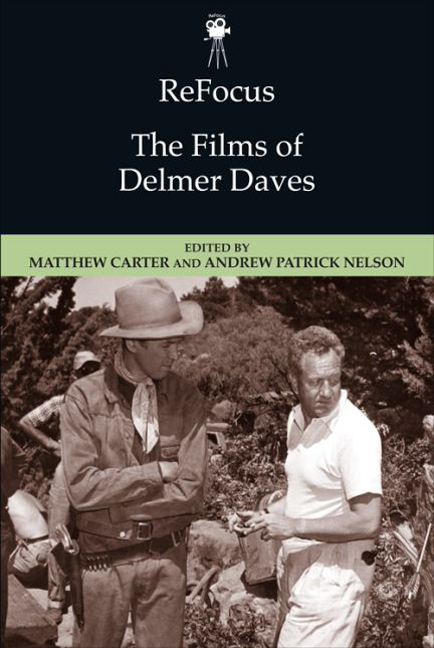Book contents
- Frontmatter
- Contents
- List of Figures
- Notes on Contributors
- Acknowledgments
- Introduction: “No One Would Know It Was Mine”: Delmer Daves, Modest Auteur
- 1 Don't Be Too Quick to Dismiss Them: Authorship and the Westerns of Delmer Daves
- 2 Trying to Ameliorate the System from Within: Delmer Daves’ Westerns from the 1950s
- 3 Bent, or Lifted Out by Its Roots: Daves' Broken Arrow and Drum Beat as Narratives of Conditional Sympathy
- 4 This Room is My Castle of Quiet: The Collaborations of Delmer Daves and Glenn Ford
- 5 Delmer Daves, Authenticity, and Auteur Elements: Celebrating the Ordinary in Cowboy
- 6 Home and the Range: Spencer's Mountain as Revisionist Family Melodrama
- 7 Delmer Daves’ 3:10 to Yuma: Aesthetics, Reception, and Cultural Significance
- 8 Changing Societies: The Red House, The Hanging Tree, Spencer's Mountain, and Post-war America
- 9 Partial Rehabilitation: Task Force and the Case of Billy Mitchell
- 10 “This Is Where He Brought Me: 10,000 Acres of Nothing!”: The Femme Fatale and other Film Noir Tropes in Delmer Daves’ Jubal
- Index
3 - Bent, or Lifted Out by Its Roots: Daves' Broken Arrow and Drum Beat as Narratives of Conditional Sympathy
Published online by Cambridge University Press: 15 September 2017
- Frontmatter
- Contents
- List of Figures
- Notes on Contributors
- Acknowledgments
- Introduction: “No One Would Know It Was Mine”: Delmer Daves, Modest Auteur
- 1 Don't Be Too Quick to Dismiss Them: Authorship and the Westerns of Delmer Daves
- 2 Trying to Ameliorate the System from Within: Delmer Daves’ Westerns from the 1950s
- 3 Bent, or Lifted Out by Its Roots: Daves' Broken Arrow and Drum Beat as Narratives of Conditional Sympathy
- 4 This Room is My Castle of Quiet: The Collaborations of Delmer Daves and Glenn Ford
- 5 Delmer Daves, Authenticity, and Auteur Elements: Celebrating the Ordinary in Cowboy
- 6 Home and the Range: Spencer's Mountain as Revisionist Family Melodrama
- 7 Delmer Daves’ 3:10 to Yuma: Aesthetics, Reception, and Cultural Significance
- 8 Changing Societies: The Red House, The Hanging Tree, Spencer's Mountain, and Post-war America
- 9 Partial Rehabilitation: Task Force and the Case of Billy Mitchell
- 10 “This Is Where He Brought Me: 10,000 Acres of Nothing!”: The Femme Fatale and other Film Noir Tropes in Delmer Daves’ Jubal
- Index
Summary
Stanley Corkin described the 1950s as the “golden age of the golden age” of Westerns. This decade also saw Delmer Daves at his most prolific. Between 1950 and 1959, Daves delivered fifteen of his thirty movies. This included a run of nine Westerns, two of which recounted some of the endmost episodes in the long history of the Indian Wars. Daves’ first and arguably most covered Western, Broken Arrow (1950), recounts the story of the famous Apache chief Cochise and his friendship with Army scout and Indian agent Tom Jeffords. Conversely, in Drum Beat (1954) Daves turned his attention to a conflict far more obscure, recalling the U.S. Army's brief albeit bloody feud with the Modoc tribe of northern California.
Frequently described as the first Western to depict Native Americans in a thoroughly sympathetic manner, Broken Arrow may indeed serve as one of Hollywood's earliest comprehensive attempts to portray them as individuals rather than the usual feathered props. While it may not have been the first major Western to cast Native American characters in a more favorable light— John Ford's Fort Apache (1948) would likely stake this claim—Broken Arrow's groundbreaking significance stems from its dwelling on the eagerly repressed history of broken treaties and encroachments on Native lands. It is often said that Broken Arrow critically engages with the myth of Manifest Destiny—and makes serious efforts to comprehensively represent Apache traditions.
Compared with Broken Arrow, the legacy of Drum Beat has not proved nearly as lasting or apologetic. Several decades after its premiere, the film remains the sole Hollywood movie covering the largely forgotten Modoc War, yet its chief merit is that of visual craftsmanship. Shot in the then-cutting-edge CinemaScope widescreen format—as opposed to the standard spherical lens used in Broken Arrow—Drum Beat presents us with some of the most glamorous images in all Western movies. As to compassion for its Native American characters, Drum Beat stands in stark contrast to its famed antecedent, making virtually no pretence of veiling its director's political affiliations with ethnographic insight.
Though it may be tempting to discard Drum Beat as an essentialist step back in Hollywood's century-long struggle with the so-called “Indian problem,” I suggest that Drum Beat can be read as a latent supplement to Broken Arrow.
- Type
- Chapter
- Information
- ReFocus: The Films of Delmer Daves , pp. 80 - 101Publisher: Edinburgh University PressPrint publication year: 2016



